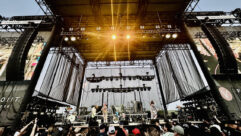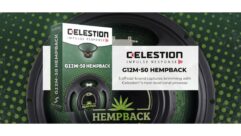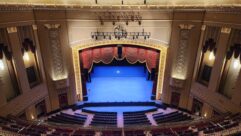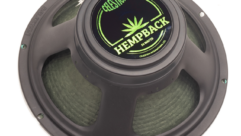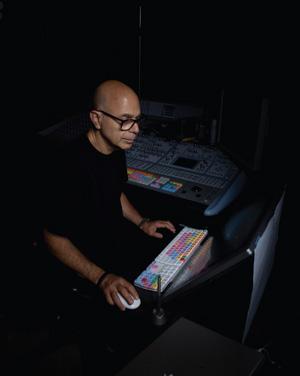

The Low End Blues
One of the biggest challenges in recording studio design is getting a great low-end sound. But the problem isn’t limited to studio designers. It has become increasingly common for AV professionals working on corporate board-rooms, presentation facilities, and other venues to struggle with clear, consistent, low-frequency reproduction.
Both of the rooms we worked on recently fell into this latter category.Another problem we found in Botnick’s studio was existing, cotton-based acoustical panel material. While this specific version of the cotton-based material is certainly absorptive at the upper-mid frequencies, with absorption coefficients of 0.9 and above, at 125 Hz its ability to absorb sound energy is limited to an absorption coefficient of less than 0.10. In general, coefficient values greater than 0.85 reflect very good performance, but values less than 0.25 indicate poor sound absorption.We also recommended using two corner bass traps from RPG Diffuser Systems and additional acoustical panels in both rear corners of the room. We also designed and installed an acoustically absorptive and diffusive soffit at the rear upper portion of the room, where the side and rear walls meet the ceiling. By creating a soffit, sound-absorbing materials could be placed away from the rear wall by as much as 2 feet, allowing several layers of material to be used while cost-effectively controlling low frequencies.
One of the biggest challenges in recording studio design is getting a great low-end sound. But the problem isn’t limited to studio designers. It has become increasingly common for AV professionals working on corporate board-rooms, presentation facilities, and other venues to struggle with clear, consistent, low-frequency reproduction.
Recently, our firm worked on a pair of rooms with nagging low-end issues. In each case we took steps to correct the rooms’ performance that any design engineer could take in his own projects. The engineer’s challenge, we found, is as much about hearing an accurate low end as reproducing it.
First, a little background on trends in sound studios. For many years, people in large and small studios monitored on two different sets of loudspeakers: large monitors, which were typically soffit-mounted, and small, near-field monitors that sat on a consoles’ meter bridge. The smaller, near-field monitors often had roll-off frequencies around 100 Hz. The idea was to use the smaller speakers, located closer to the mixer, to reduce the influence of the room. But in doing so, people gave up an accurate low end.
More common today is the use of what we call “semi-near field monitors.” These monitors are typically used in close proximity to the mixer and are essentially full-range devices, with roll-off frequencies usually below 50 Hz. In dedicated mixing and mastering rooms, it’s increasingly common to see large-format monitors standing on the floor 11 to 13 feet from the mixer. In this case, the tonal balance of the room is especially critical because there is no attempt to reduce the influence of the room.
UNHAPPY FROM THE GET-GO
Bruce Botnick is a well known sound engineer, with a resume that spans work in film, rock music (including all The Doors albums), Broadway show soundtracks, and television. In late 2003, Botnick built a mixing room north of Los Angeles, out-fitted for both stereo and 5.1 mixing. From the time it opened, though, Botnick was unhappy with the low-end performance of the room.
The complaint was actually one we hear often. Botnick found that the low end was uneven, with certain frequencies booming while others were seemingly missing. There was also a great deal of variation in the low end at the mix position as compared to a producers’ couch located 10 feet behind the mixer. These problems left Botnick unhappy with his facility and unable to trust that the low end of mixes he was working on would translate to other systems.
About the same time, we were called into Tangerine Mastering, a new mastering facility in Weehawkin, N.J. Their complaint was almost identical to Botnick’s. Facility owner Roger Johanson and his engineers were concerned that low-end sound in the room was inaccurate and lacked impact and clarity. Like Botnick, Johanson needed his room to both sound great and perform accurately in the low end.
Both rooms—Botnick’s and Tangerine Mastering’s—feature very high-end loudspeaker systems. Bruce uses B&W Nautilus series, while Tangerine features Dunlevy SC4a monitors. Both sets of loudspeakers were designed to deliver a tight, clean, and even low-frequency response. Trusting that to be true, we started to look at the rooms themselves.
MUSICAL SAMPLES FOR CRITICAL LISTENING
For listening to rooms and systems, we as acoustics designers carry an iPod with uncompressed WAV files. We use a wide variety of music, but much of it falls within simple guidelines:
- The recordings should have a clean, clear sound, not layers of reverbs.
- They should feature clean kick, bass, and snare sounds.
- There should be least one clear female vocal.
- And at least one solid acoustic bass sound.
- Finally, the recording should cover a wide dynamic range.
Here’s some of what’s on our iPod now:
“Black Eyed Pea,” by Galactic, New Orleans funk masters. Dynamic and kickin’, with great rock guitar sounds and Stanton Moore’s drums.
“Church,” by Lyle Lovett. A kick drum that sounds just like a kick drum. This song will make you smile and lose concentration on the sound.
“Day Is Done,” by Charlie Hunter. Hunter plays an eight-string guitar/bass hybrid. This is a song with a sparse bass line, percussion, and very a familiar female vocalist.
“Debe,” by Ali Farka Toure & Toumani Diabate. A guitar and Kora duo song with some vocals. The transients are amazing (the Kora has many high strings); great for hearing high-mid and high-frequency performance of monitors.
“Prelude in F-flat,” Arcadi Volodos plays Rachmaninoff. One of the finest piano performances and recordings ever.
“Signed Sealed Delivered,” by Steve Bernstein’s Millennial Territory Orchestra. Cover of a classic. Ben Allison’s full bass sound, an electric slide guitar, fun vocals, a scratchy violin, and crazed horn section make this a great way to listen to a system.
“Sunflowers,” by the Wynton Marsalis Septet. Dynamic horns, a tambourine, and bass playing a vamp in 5. Great groove.
“Voodoo Child,” by Angelique Kidjo. A groove/hip-hip version of the Jimi Hendrix classic. She sings and chants above a snappy snare and killer bass line.
“The Weight” and “You Gotta Move,” by Cassandra Wilson. Two covers with a wide frequency range, sparse percussion, slide acoustic guitar, and Wilson’s husky vocals.
In evaluating any room, our approach is always the same: critical listening and careful acoustic measurement. The critical listening part simply requires playing back music that we know well and which provides a clean, tight low end. Though straightforward, the importance of listening can not be overstated. We use a wide range of rock, jazz, hip-hop, and classical music (see “Musical Samples for Critical Listening” for sample selections) to appreciate a room’s low-end (and other) sound characteristics.
For acoustic measurement, we use two features of our firm’s own SIA-Smaart 5 software, the Fixed Point Per Octave (FPPO) transfer function and the impulse response. We use the transfer function to see which frequencies are being supported and which are being canceled at both the mix position and other positions around the room. The impulse response is used to look at the overall decay of sound in the room.
When we perform our measurements, whether in a sound studio or other room, we’re looking for two critical issues: the relative decay times for mid and low frequencies, and the evenness of the decay at low frequencies. Both of these measurements could indicate the room is acting modally—and that there is a need for treatment beyond simple acoustical panels.
PAIN IN THE REAR
In both Botnick’s and Tangerine’s rooms, our recommendations focused on the design of the respective facilities’ rear walls.
For Botnick, we rebuilt the wall, creating asymmetrically cut corners and a large soffit at the top of the wall. While asymmetry is often considered undesirable in studio design, carefully designed asymmetry in the rear wall (particularly at the corners) can help to reduce modal behavior and create a more even low-frequency response. The new wall featured two types of bass absorbers from RPG Diffusor Systems and two types of diffusive treatment, as well as a large amount of 6-pound-density glass fiber.
The configuration of the soffits allowed us to place absorption with a large airspace behind it and along the rear wall. Botnick was concerned that adding so much absorption would create a dead feel in the room. However, much of the absorptive material was mounted behind diffusive treatment, which scatters mid and high frequencies and allows the low frequencies to reach the absorptive materials. This resulted in a room that is both acoustically live at mid and high frequencies, and well controlled at the low end.
When designing or retrofitting a room, it’s critical for designers to ensure that the materials and techniques they select address the entire audio spectrum.
At Tangerine both our listening and acoustic measurements confirmed that the low end was behaving modally. There appeared to be two types of frequencies in the room: those that were resonating and those that were getting cancelled out at the same time. This is typical of rooms where modal behavior dominates the low end.
An inspection of the acoustical treatment of the room showed that although there were many acoustical panels and a large area of foam diffusers on the rear wall, all the acoustical panels were just 2-inch-thick glass fiber, mounted on or near the walls. Panels that were angled from the walls were not backfilled with lower density fiberglass, which is one way to improve low-end performance.
Furthermore, the diffusers selected were mounted directly to the rear wall, without placing materials behind them, allowing for effective low frequency absorption without overly deadening of the space. We added the missing fiberglass, which improved the ability of the existing and new materials to control low frequency energy (particularly in the 125 Hz range).
In both the Botnick and Tangerine rooms we were ultimately able to improve the evenness and accuracy of the low-frequency response by substantially reducing modal behavior. Moreover, in both cases the modifications represented a small fraction of the cost of the studios’ original construction while resulting in dramatically better sound.
In retrospect, the initial acoustical designs in these rooms did not fully meet the users’ expectations because not enough attention was paid to controlling mid-low and low frequency energy. We actually find this is a common mistake not only in mixing and mastering rooms, but also in home theaters, screening rooms, and corporate boardrooms where speech can be degraded by “boomy” acoustics.
As these two cases illustrate, though, careful selection of materials and attention to mounting details can help resolve problems for even the most demanding situations—and result in great sounding rooms and happy clients.
Sam Berkow is the founding partner of SIA Acoustics, an acoustical design firm with offices in New York and Hollywood, Calif. Recent projects include the Studios of the Clive Davis School for Recording Arts at New York University and the concert halls and jazz club for Jazz at Lincoln Center.
Q&A With Bruce Botnick
Credit: Photo: Kelly Fajack/WPN
SAM BERKOW: You built your studio primarily as a surround-capable mix room. Can you talk a bit about how you use this room? How much of your work is surround?
BRUCE BOTNICK: I use the room mostly for mixing in stereo, as the surround business has become somewhat mute. However for music scores for films, 5.1 is the format.
BERKOW: Your work spans TV, film, and music, mixing and tracking. In an age of specialization how do you see your job?
BOTNICK: In my early days, I was considered a engineer—at least that’s what the credits said. Later on after recording everything under the sun—commercials, children’s albums, musicals, classical, jazz, rock, and, my two favorites, country and western—I moved into producing, recording, mixing, and dubbing music for motion pictures.
The landscape has broadened greatly, and I have many job titles, but “music maker” sums it up. Be it 5.1, stereo, mono, analog, vinyl, or digital, the bottom line is that we’re still making music and the format is nothing but a vehicle. With time, everything is new and everything is the same—just the toys change.
BERKOW: You brought us, SIA Acoustics, in to help address low-frequency issues in your room. At what point did the low-end problems become disturbing enough for you to take corrective action?
BOTNICK: From the beginning I noticed that the low frequencies weren’t up to snuff and I was always guessing as to what the bottom really was. Since I completed the room in early 2004, I’d been on a quest to find the low-frequency holy grail. At every opportunity I’d plea with anyone who would listen to direct me to someone who truly understood the art of acoustics.
BERKOW: When we first met in your space, we spent some time listening to the low end in various locations. How important were those listening sessions?
BOTNICK: Listening is everything. Some of what I hear is in my imagination and I’m able to translate that into something concrete. The listening tests were great because in a very short time we were able to confirm what I wasn’t hearing and translate that into a meaningful solution. I’m so happy that I can now hear the bottom anywhere in the room.
BERKOW: We’ve talked about how to achieve a consistent, tight, accurate low end. What tricks do you use for placing subwoofers when you work in rooms other than your own?
BOTNICK: When I work at other studios and use my own loudspeaker system, the first thing that I do is ask the A2/2nd engineer where the best place in the control room is to put the LFE [low-frequency effects]. The second thing I do is to place the LFE at the mix position, play a repeating sweep from 40 Hz to 100 Hz, and walk around the room listening, with my trusty Radio Shack sound pressure meter in hand. When I find the sweet spot, that’s where I place the LFE.
Most of the time it coincides with what others before me have found; other times not. I’ve also found the best way to overcome blockage and erroneous reflections from the LFE blowing into the back of a console is to have it on its back, blowing straight up towards the ceiling. That seems to get the best and most accurate dispersion.



